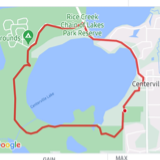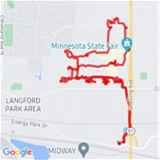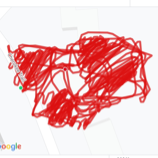Regional Teams: Why Take the Time? Why Make the Effort?
Jonathan Wicklund
Interim Regional President, Converge North Central
- Church strengthening
All three of my kids and their spouses run. I mean, they do it for fun. No one’s making them do it. I have no idea where they got the idea that running outside year-round in Minnesota is enjoyable. They certainly didn’t get it from me. They all started after they moved out.
But they’re into it. They do 5Ks, 10Ks, half marathons, and full marathons. They’ve done races in Fargo, Grandma’s, the Twin Cities, New York, and even Boston.
Me? I don’t run. I walk. I started walking a few years ago because, well, I wasn’t getting any younger and I needed to do something. When COVID hit, I kept walking around my neighborhood and on the trails nearby. I got an app to map my walks so I could see how far I was going. It saves my routes, and here are a couple:


 I even turned the app on when I mowed the lawn. You can see, I was going “back and forth.” Not to be confused with..
I even turned the app on when I mowed the lawn. You can see, I was going “back and forth.” Not to be confused with..
 ...the more front-to-back direction.
...the more front-to-back direction.
I won't even get into mowing at an angle. I know. I have a problem. So yeah, I track my walks. It's for me. No-one else really sees it. It's interesting and gives me some data and perspective.
But my kids, they’ve taken things to a whole other level. Running is pretty individualistic—just you and the road. How fast can you go? How far can you go? Can you shave some time off your personal record? Can you save some energy for the final kick? It’s a mental game where your head says, “Let’s go!” and your body says, “I’m not so sure this is a good idea anymore.”
What I’ve learned from my kids, and maybe you already knew this, is that there’s a huge sense of community among runners. It can look a lot like the faith community the Bible talks about. For my kids and their spouses, this is mostly through an app called Strava.
Strava started about 15 years ago by two friends who missed the camaraderie of their college athlete days. They wanted a place where people, regardless of activity level or goals, could have a community supporting and encouraging them.
My youngest, Levi, is new to running. When he finished his first 10-mile race, his Strava page was full of encouragement. One of his brothers even joked on the app that his smartwatch must have been stolen because he did so well.
Another son, Jared, ran a race and posted pictures of his cheering section on Strava, thanking them for their support.
Greta, my daughter-in-law, ran Grandma’s and qualified for Boston. Her Strava page was overflowing with love, support, and encouragement.
My kids connect with cousins, friends, and others who love running. They’re part of this Strava community where they track each other, encourage, build up, and support each other.
Now, as pastors, we preach and encourage our church members to be part of smaller communities, like small groups and service teams. We teach the value of these communities and how they offer something that larger group settings can’t.
But here’s the question: Pastor, are you part of a smaller community?
Are you experiencing a smaller community with other pastors and church leaders, where you can support and build each other up? Where you can share the challenges of ministry, get new ideas, and gain fresh perspectives in a safe space?
One thing I’d tell my younger self starting out in ministry is to prioritize being involved in a smaller community of other pastors. Pastors serving in similar contexts, with more experience to share their wisdom. Pastors with whom you can share joys, frustrations, best practices, victories, and challenges.
Converge North Central has had pastor groups for many years, under different names and focuses. We’ve put a lot of thought into our current structure of Regional Teams.
Minnesota and Iowa are divided into several smaller regions, each with a leader. These teams gather regularly to create a relational infrastructure for encouragement, equipping, communication, and advancement. They meet four times a year to be “better together” through prayer, dreaming, and ministry building. Think of regional leaders as your biggest cheerleader and the regional team as an in-person Strava app—no marathon training required!
When your regional team leader reaches out, have a conversation. Learn what’s happening in your region.
Also, some areas in our region need a regional leader. If you’re unsure who your regional leader is or want to know more about the role to fill a need, contact me at jnelson@convergenorthcentral.org.
And let us consider one another in order to provoke love and good works, not neglecting to gather together, as some are in the habit of doing, but encouraging each other, and all the more as you see the day approaching. Hebrews 10:24-25
Jonathan Wicklund, Interim Regional President, Converge North Central
Interim Regional President
Additional articles by Jonathan Wicklund
